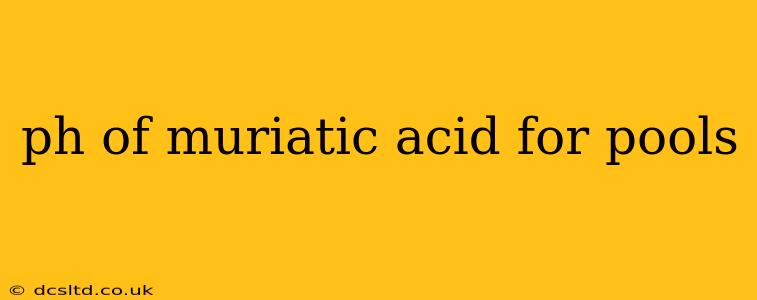Muriatic acid, also known as hydrochloric acid (HCl), is a strong acid commonly used to lower the pH of swimming pools. Understanding its properties and proper application is crucial for maintaining a safe and healthy swimming environment. This guide will delve into the pH of muriatic acid, its use in pool maintenance, and important safety precautions.
What is the pH of Muriatic Acid?
Muriatic acid, in its concentrated form, has a very low pH, typically around 1. This indicates a highly acidic solution. It's crucial to remember that this is NOT the pH you're aiming for in your pool. Pool water should ideally have a pH between 7.2 and 7.8. Muriatic acid is used to lower a high pH, bringing it back within the acceptable range.
How is Muriatic Acid Used to Lower Pool pH?
High pH in a swimming pool can cause several problems, including cloudy water, scaling, and reduced effectiveness of sanitizers like chlorine. Muriatic acid neutralizes alkalinity, thereby lowering the pH. However, it's a powerful chemical and requires careful handling and precise measurement. Never add muriatic acid directly to the pool water. Always follow these steps:
- Test your pool water: Use a reliable test kit to accurately determine your current pH level.
- Calculate the amount needed: Use a pool calculator or consult your pool professional to determine the appropriate amount of muriatic acid needed to adjust the pH to the desired range. Adding too much can drastically lower the pH, potentially damaging pool surfaces and equipment.
- Add the acid slowly and carefully: Pour the muriatic acid into a plastic container and slowly add it to the pool while the pump is running. Avoid splashing and ensure proper ventilation.
- Retest: After adding the muriatic acid, wait several hours and retest the pool water to check the pH level. Repeat the process as needed, making small adjustments until you reach the desired range.
Safety Precautions When Using Muriatic Acid
Muriatic acid is corrosive and dangerous if mishandled. Always adhere to these safety precautions:
- Wear appropriate safety gear: This includes safety glasses, rubber gloves, and protective clothing.
- Work in a well-ventilated area: Muriatic acid fumes can be irritating and harmful.
- Keep children and pets away: Never allow children or pets near the pool while adding muriatic acid.
- Store muriatic acid properly: Keep it in a tightly sealed container in a cool, dry place, away from other chemicals.
- Neutralize spills immediately: In case of a spill, neutralize it with baking soda and then clean it thoroughly.
- First aid: In case of skin contact, immediately flush with water for at least 15 minutes and seek medical attention. If ingested, immediately contact a poison control center or emergency services.
What Happens if I Add Too Much Muriatic Acid?
Adding too much muriatic acid can dramatically lower the pool's pH, making the water too acidic. This can lead to:
- Corrosion of pool surfaces and equipment: Acidic water can damage plaster, tile, and metal components of your pool.
- Skin and eye irritation: Swimming in overly acidic water can cause discomfort and irritation.
- Reduced effectiveness of sanitizers: An extremely low pH can hinder the effectiveness of chlorine, leaving your pool vulnerable to algae and bacteria.
If you accidentally add too much muriatic acid, you'll need to raise the pH using a pool pH increaser, typically sodium carbonate (soda ash). Again, carefully follow the instructions and retest your water frequently.
How Often Should I Check and Adjust My Pool's pH?
Regularly checking and adjusting your pool's pH is crucial for maintaining a healthy and balanced swimming environment. It's recommended to check your pool's pH at least once a week, or more frequently during periods of heavy use or extreme weather conditions.
What are the signs of high pH in my pool?
Signs of high pH in your pool often include cloudy water, scaling on pool surfaces, and a less effective chlorine sanitizer. You'll likely notice a higher than normal reading on your pH test kit.
Can I use other chemicals to lower pool pH instead of muriatic acid?
While muriatic acid is a common choice, other chemicals can lower pool pH. However, these alternatives may require larger quantities or have different handling precautions. Consult your pool professional for recommendations on suitable alternatives.
This comprehensive guide provides detailed information about the pH of muriatic acid and its use in pool maintenance. Remember to always prioritize safety and follow the instructions carefully. If you are unsure about any aspect of pool chemical handling, consult a qualified pool professional.
